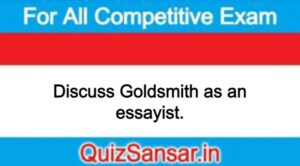
Discuss Goldsmith as an essayist.
Discuss Goldsmith as an essayist.
Ans.
Goldsmith was a great poet. dramatist and prose writer. His prose works are of an astonishing range and volume. His important prose works are his essays contributed to The bee and The Citizen of the World. It is a series of imaginary letters from a philosophical Chinaman who wrote letters to a friend in Peking from London These letter gave Goldsmith the opportunity of ex pressing his own mind upon the society and literature of the day. His essays especially those in The Bee and admirable. His other important work is the novel The Vicar of Wakefield which is in the first rank of the eighteenth century fiction. Besides these works, Goldsmith compiled histories of Greece and Rome and a work on natural history entitled Animated Nature. He also wrote short memoirs and lives, such as Life of Beau Nash, Life of Bolingbroke, and Memoir of Voltaire.
Goldsmith occupies a dignified place as an essayist in the domain of English essay. He wrote essays on philosophical subjects like essay on ‘Happiness, and social subjects, like the essays on Doctors’. His essays are marked with whimsicality, satire, mild humour and graceful charm. Goldsmith’s es says are satirical reflections upon the society of his time. He criticizes manners and ideas of English people. He mixed satire with a note of moral teaching. interning to reform the evils and teach the readers sound lessons in morality. which is combined with a note of tenderness and sympathy touching the heart.
Goldsmith at times could be sentimental. With tears he could have laughter and the two qualities go together in his work. melancholy is also a part of his writing. It succeeded in making him tongue-tied and wistful but careless. An easy going gaiety broke through all the barriers and brought out the writer in the broad sunshine of mirth and humour.
Goldsmith’s essays are varied in tone. The Bee, a periodical paper, which appeared only eight Saturdays in October and November, 1795, contains some of his best small poems as well as an amusing diversity of prose criticisms, moral tales and serious or merciful discourses. Goldsmith excels in human details. In The Bee and other groups of essays we find interesting ideas expressed and we meet such interesting character as the ‘Strolling player’ who reminds us of Goldsmith himself, as well as the Print Sentinel, a colossal monument of human distress and fortitude, and above all, the immortal Beau Tibbs, one of the most delightful characters of the century. Goldsmith was contented by preoccupied with vivid and rich human details, he creates his characters real like people.
The Citizen of the World is certainly the best example in English of the essay device very popular at the time France, which made Goldsmith a foreign traveler who wrote letters to his home country describing and criticizing the strange customs of the lands through which he passed. These Chinese letters give a picture of Goldsmith’s mind and the temper of his time. He is a patriot, but a patriot who is sure that each nation has its individual and super lative merit as well as a contrasting defect. He thinks that this philosophic mind will attempt to absorb the diverse merits of all nation. Then it was appropriate to call the Chinese letters by the title of the Citizen of the World. The title is philosophical rather than political. In implication.
Goldsmith’s Prose Style:
Much praise has been given to Goldsmith’s style. In his essays his style is graceful, charming and amiable. His style is always pure and easy, and on proper occasions, pointed and energetic. The language of Goldsmith is always light, pleasing and refreshing, bathed in the sunshine of humour or the tenderness of pathos. Even the sentence structure constantly changes according to the needs and the mood of the writer. The sentences are sometimes brief. some times long, some times straight and antithetical and so on. In short his charming personality is reflected in the charm of his style. It is what may be called a soothing style simple, spontaneous, quiet and fluents which is even more pleasing than that to Steele and Addison.
To sum up, we agree with prof. R. D. Trivedi. “His essays are every where informed by his lovable personality. His simplicity, sweetness, tender and tolerant humanity shine on every page. He had also a penetrating sense of humanity which enabled him to seize the essence of a character in the fewest possible words, his ‘Beau Tibbs’ and the ‘Man in Black’ are unforgettable.”
-
Write the critical appreciation of the poem No. 12 entitled Far Below Flowed.
-
Write the critical appreciation of the poem No. 11 entitled Leave this Chanting.






